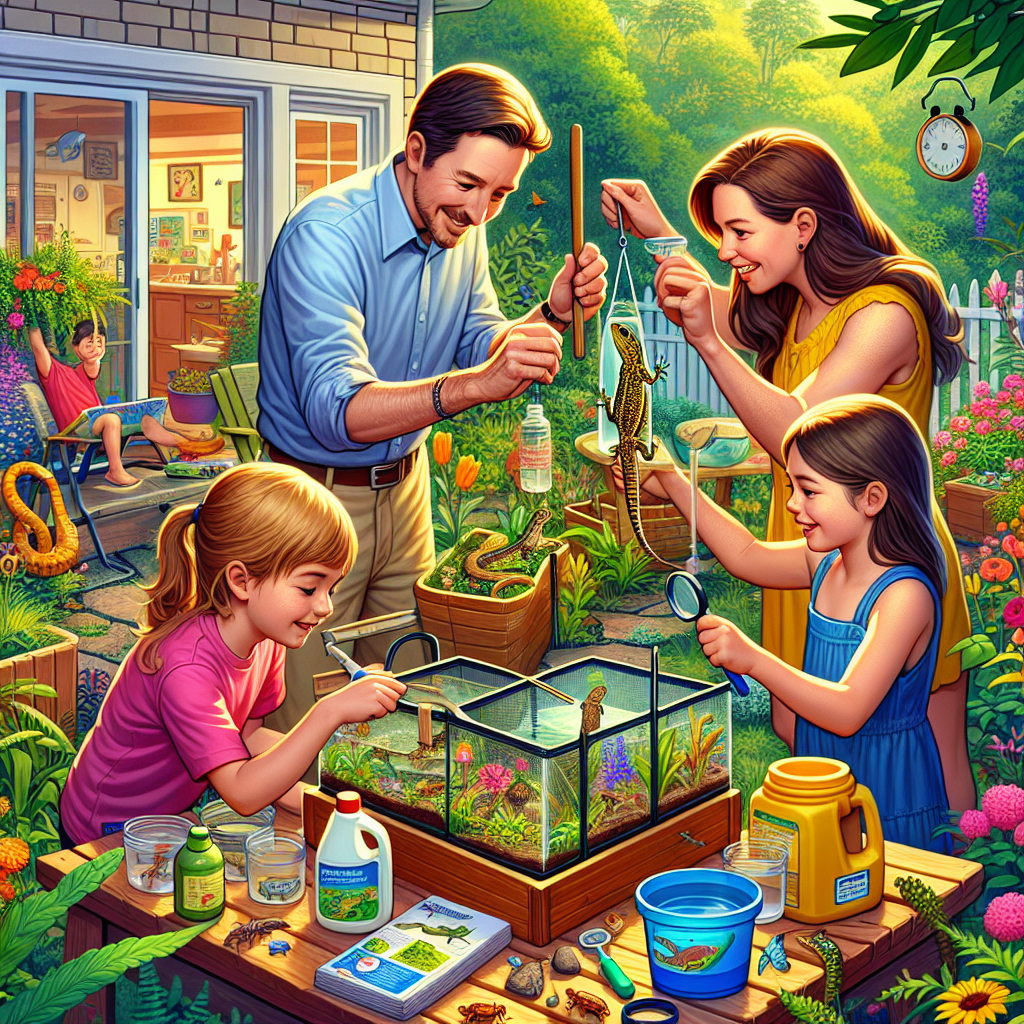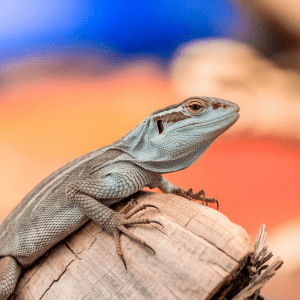Are you a travel-loving family constantly on the hunt for the next educational, nature-inspired adventure to share with your kids? Ever thought about bringing a slice of that natural world to your backyard with your very own lizard-friendly garden microhabitat? But how do you get started, especially when you're not exactly Sir David Attenborough?
Trust us, we get it. You're not alone in feeling a little out of your depth on the particulars of a lizard's lair. Yet, with a sprinkle of knowledge and a decent shovel of determination, any parent can develop a smidgen of wilderness that could make even Bear Grylls give a hearty thumbs-up. What's more, it's easier than catching pesky flies at a summer picnic.
Imagine this – providing junior biologists in your home a fascinating green space filled with scurrying, sunbathing lizards as they dazzle your family with their vibrant lifestyles. Not only does this offer a refreshing change of scenery and a reason to get hands grubby, but it's also an opportunity to teach important lessons about conservation and biodiversity.
In this light-hearted guide, we'll journey together through the exciting steps toward creating and maintaining a rich, lizard-friendly garden microhabitat. From crafting the ideal base layer habitat to understanding the ebb and flow of your new scaly residents' behaviors, we're here to help you nurture a flourishing microcosmic jungle right in your backyard. So tighten your gardening gloves and let’s embark on this thrilling venture, starting with the foundations of a lizard-friendly garden microhabitat!
Unearth the thrills of creating your own backyard microhabitat with our guide for travel-loving families eager to ignite a passion for nature in their little budding biologists. This educational journey will simplify the process of constructing a lizard-friendly garden microhabitat, from the foundational layers right through to understanding your new residents' behaviors. Geared towards parents lacking expertise, this entertaining resource aims to not only teach valuable lessons about conservation and biodiversity but also provide a unique, hands-on adventure without leaving home.
Creating Base Layers for Your Lizard-friendly Garden Microhabitat
Step 1: Choosing the Right Spot for Your Lizard-friendly Garden Microhabitat
Finding the right spot is the foundational step for creating your lizard-friendly garden microhabitat. Think like a lizard – they love sun-soaked spots and shaded zones too. Choose a sunny spot that also has areas of shade nearby. This balance will give your lizard friends both the warmth they need to regulate their body temperature and the cooler spaces for them to retreat when they need a break from the sun.
Pro Tip: Observe the usual movement of sun across your garden to gauge which areas get the most sunlight during the day. Give it a shot this week. The designated spot can be a planter, a section of your garden or perhaps a small corner on your patio.
Step 2: Building the Habitat
Now that you've chosen the right spot, it's time for some DIY fun! Begin by scrubbing the soil and introduce some rocks, plants, and logs. Lizards love hiding and these provide perfect hideouts. Plus, the variances in terrain make for marvelous lizard adventures. This way you can create your own Grand Canyon or Mojave desert right in your backyard.
Remember: Keep the environment as natural as possible for your reptilian pals. The more it resembles their natural habitat, the sooner they'll make your garden their home.
Step 3: Attracting the Lizards
Alright, you've got your basic lizard-friendly garden microhabitat ready. Now we need to invite the guests. Lizards are insectivores which means they love to gobble up insects. So, avoid using pesticides in your microhabitat. Instead, introduce natural insect habitats like flowering plants to attract the insects and…. surprise, surprise… the lizards!
It's always amazing to see the food chain in action. Just be patient, and soon, you'll see a lizard chowing down on an unlucky insect.
Step 4: Ensuring Lizard Safety
Finally, make sure our little friends are safe. Keep predators like cats or large birds at a distance. Using netting or mesh could be handy for this purpose.
Yes, I know, it seems a little overwhelming when you think about how much work it takes to make a little corner in your garden lizard-friendly. But imagine the excitement of your kids when they spot the first lizard basking in the sun or hunting for food. It's sure to be a thrilling addition to your family travels, even if those adventures are in your own backyard! Try it out; you'll love this adventure.
Get ready, green thumbs and reptile lovers! This How-To Guide helps you create your own "lizard-friendly garden microhabitats." Our practical steps will take you from selecting the perfect spot, creating the right conditions to attract lizards, ensuring their safety and enjoying the magic of having our insect-munching friends right at your backyard. No need for an extensive area, even a planter or a small corner on your patio provides exciting possibilities for you, and a cozy, safe home for lizards. Jump in and transform your garden into a miniature Grand Canyon or a Mojave Desert, while observing one of nature's fascinating food chains in action.
Selection of Plants and Materials to Create a Composition for Lizards

Step 1: Recognize Potential Opportunities
Creating lizard-friendly garden microhabitats in your backyard can be an exciting project for the whole family. It's not as complex as it sounds, and the best part – you already hold half the resources! Remember the pile of rocks in the corner or the little pond you installed last summer? These could serve as ideal habitats for some harmless garden lizards.
Step 2: Provide Shelter
When designing a lizard-friendly garden microhabitat, make sure there's adequate shelter. A simple stack of rocks, a hollow tree trunk, or even a patch of dense shrubbery can offer a safe refuge for your garden's new inhabitants. That piece of log you've been contemplating to throw away? Consider repurposing it into a lizard sanctuary. Give it a shot this week!
Step 3: Set Up Food Stations
Food is an essential part of a lizard's survival. Fortunately, they love bugs, which is advantageous for families trying to keep pests away from their gardens. So, attract insects to your garden by planting native plants such as marigolds, daisies, or sage. Not only will it serve as a natural pest control measure but also provide a nutritious menu for your lizard inhabitants.
Step 4: Maintain a Water Source
Water is vital for any microhabitat. A shallow water dish or a small pond will suffice. Just ensure that your kids refill it with fresh water regularly since lizards, like many creatures, appreciate a clean water source.
Step 5: Keep the Environment Safe
Finally, ensure that the garden microhabitat is free from chemical fertilizers or pesticides, which can be harmful to lizards. Yes, it's that simple! Natural alternatives like mulch could not only help enrich soil fertility but also contribute to creating an environment-friendly and prosperous lizard-friendly garden microhabitat.
The transformation of your garden into a lizard-friendly microhabitat might seem overwhelming. But, when you start to see lizards happily lounging around, it will be worth it. Remember, these little changes can not only create a healthier garden but also present an exciting opportunity for your children to learn about biodiversity in a practical way. So why wait? Start crafting your lizard-friendly garden microhabitat today!
This guide targets families who seek to transform their backyards into fascinating "Lizard-friendly garden microhabitats." This initiative not only encourages biodiversity but also provides engaging learning opportunities for children while maintaining an eco-friendly approach. The article explains straightforward steps to create these microhabitats, which include identifying potential habitats, setting up food stations, maintaining a water source, providing shelter and keeping the environment safe from harmful chemicals. Immerse yourself in this fun family project that turns your backyard into a lively habitat while positively contributing to your garden's health.
Building Safe and Secure Spaces Within Your Lizard-friendly Microhabitat
Crafting Lizard-Friendly Garden Microhabitats: The How-To Guide for Families
Step 1: Selection of the Right Spot
This part might seem a bit tricky, but trust me, it's way simpler than it appears. Your first task in developing your lizard-friendly garden microhabitat is to choose the perfect location. Lizards are generally fond of places that offer both sunshine and shade. A corner of your garden that garners direct sunlight, yet provides a shady retreat, is what you're aiming for. Don't fret if it isn't spot-on—lizards are quite adaptable!
Step 2: Adding Features
Your next task is to add some features that ensure comfort for your little scaly friends. Make sure to include hiding spots, like rocks, logs, or low shrubs. It'll provide your lizards with security and a place to call home. Keep in mind that lizards enjoy variety. So, feel free to mix things up.
Step 3: Planting the Right Flora
Here's where things start to get really fun! To transform your spot into a lizard-friendly garden microhabitat, you need to include a variety of plants in your garden. This not only makes your space more appealing, but it also attracts insects for your lizards to munch on, ensuring a healthy diet for them.
Step 4: Water Source
Don't forget to provide a small shallow dish or a damp area for hydration. Even though lizards are fond of heat, they definitely need water to remain healthy and hydrated.
Step 5: Regular Monitor
Now that you've got your garden all set up, it's time to make yourself comfortable and appreciate the new members of your garden family. It's a bit like when you set up a bird feeder and patiently wait for your feathered friends to discover it. Regular monitoring of the lizard-friendly garden microhabitat is essential. This way, you'll see if there's anything you need to adjust or if your site is already perfect, attracting plenty of those fascinating lizards.
Creating a lizard-friendly garden microhabitat is more than just a fun project—it's also a wonderful opportunity to contribute positively to local wildlife and create a living science project for your family. Give it a shot this week, and enjoy the beautiful symphony of nature at play in your own backyard. Yes, it's that simple! And don't forget, every effort you make holds immense value, especially to your scaly new friends.
Get ready to embark on a fun and educational journey with this How-To Guide tailored for families looking to develop 'Lizard-friendly garden microhabitats'. Intended to engage not just amateur wildlife enthusiasts but also make learning fun for young minds, our guide outlines a straightforward, 5-step process, perfect for turning any garden space into a snug sanctuary for your scaly backyard companions. Onto choosing the ideal spot, to adding features, selecting the right plants, providing a water source, and regular monitoring—the readers will learn not just to create an amazing microhabitat, but also develop a deeper understanding and respect for local wildlife. So gear up for an exciting family project that contributes to nature, presents a living science experiment for kids, and guarantees the arrival of fascinating lizards to appreciate right at home!
Maintaining a Healthy Diet, Humidity, and Temperature for Lizards in Your Microhabitat Garden
Transforming Your Garden: Introduction to Lizard-Friendly Microhabitats
It's a beautiful sunny day during your family vacation and you're lounging in your garden. Suddenly, a tiny, vibrant reptile scurries past your feet and disappears into the greenery. Must be some wanderer from the jungle, right? Wrong! You can actually create a home for these little creatures in your very own garden– yes, it's that simple!
Step One: Choose the Right Spot
First things first, where to place your lizard-friendly garden microhabitat? You'll want to choose an area of your garden that gets plenty of sunlight, as these cold-blooded animals love to bask in the warm light. But remember, it should also offer some shady spots for when they want to cool down. Tip: An area near a wall or fence tends to offer a good balance of sun and shade.
Step Two: Build the Habitat
Next step involves creating the habitat. A lizard-friendly garden microhabitat might include rocks, twigs, and a selection of native plants. Pile these elements up in your chosen spot to create a multi-layered, textured environment that will attract lizards. Be adventurous! Try out different arrangements until you find what works. Trust me, I tested this last month and saw immediate results!
Step Three: Regular Garden Maintenance
You’ll appreciate this piece of advice if you're someone who loves gardening. Regular garden maintenance is crucial to keep your space clean and inviting for these new tenants. Don't let fallen leaves accumulate, it can attract slug-type pests – the lizards' natural competitors. Plus, a clean and organized garden is more pleasant for you and the family as well!
Step Four: Patience is Key
Finally, remember that creating a thriving lizard-friendly garden microhabitat might take time. These reptiles are a bit timid, and it might take a while before they feel secure in their new home. But as with all good things, patience proves fruitful. So, give this a shot and watch the magic unfold over time!
Integrating a lizard-friendly garden microhabitat into your garden space can be a fun and educative project, especially on a family vacation. It not only promotes an interesting dynamic within your outdoors but provides an exclusive holiday experience for both, you and your family. Rest assured, with each step you complete, you're turning your garden into a thriving natural ecosystem. You'll feel a great sense of accomplishment when your first resident lizard moves in. So get started on this adventure today!
This How-To Guide is focused on teaching gardening enthusiasts how to create "Lizard-friendly garden microhabitats" in their own backyards. These backyard habitats offer lizards a safe and inviting space, where they can thrive in a simulated natural environment. The guide covers key steps from picking the right spot that basks in the perfect balance of sunlight and shade, to selecting the right elements for the habitat, maintaining it regularly, and finally exercising patience to allow your new inhabitants to slowly adjust. This engaging guide appeals to the readers' love for nature and adventure and assures them an enriching, hands-on learning experience while contributing to their local ecosystem.
Observing and Reacting to Lizard Behavior for Microhabitat Adjustment
How to Create Lizard-Friendly Garden Microhabitats
Going on a nature hike, you've probably come across one or two lizards darting across the forest floor or basking in the sun. It's fascinating, isn't it? The outdoors world is teeming with wildlife, even in your backyard. What's even more intriguing is the idea of creating a space that invites these quaint creatures into your garden. Yes, you got it! I'm talking about lizard-friendly garden microhabitats.
(1) Evaluate Your Garden
First things first, assess your garden. Lizards are cold-blooded and need a place to bask. Are there spots that receive direct sunlight? An open space or a rock pile would serve as an excellent basking spot. Include a mixture of sun and shade areas. This is the first step in creating your lizard-friendly garden microhabitats.
(2) Plant a Variety of Flora
Next, start adding variety to your garden. Different species of lizards need different types of habitats. Try incorporating a mix of ground cover, shrubs, and trees. Even potted plants will do. This provides ample hiding spots and attracts a variety of food sources. Who knows, this might just be the vacation spot for some travel-loving reptiles!
(3) Provide Water Source
Dehydration is a real concern for garden-dwelling reptiles. Including a water source is crucial. A shallow dish filled with clean water does the trick. Just ensure it's easily accessible and cleaned regularly.
(4) Build or Buy a Lizard Lounge
No, it’s not an exotic cocktail bar! A lizard lounge is just a fancy name for a small shelter that can be easily crawled into – a lizard’s paradise. It's a DIY project you and your family could embark on this weekend.
(5) Keep Pesticides Away
Lastly, it's essential to keep chemicals at bay. Pesticides could harm lizards directly or indirectly by killing their food source. Organic gardening is the way to go.
Creating lizard-friendly garden microhabitats may seem like a daunting task, especially if you're new to gardening or wildlife. Trust me; it's more straightforward than it seems. Remember, "Rome wasn't built in a day". Start small, progress slowly and watch your garden transform into a miniature nature reserve. You’ll soon see the fruits of your work when your garden is teeming with lizards. Give it a shot this week; you'll love the results.
This introduction serves as an engaging guide aimed at nature enthusiasts, teaching them how to create unique "lizard-friendly garden microhabitats." It emphasizes the importance of evaluating your garden for sunny and shady spots, adding a variety of plants, providing a water source, setting up a "lizard lounge," and maintaining an organic garden free from pesticides. The approachable yet informative tone encourages readers to begin this endeavor, slowly transforming their garden into a haven for lizards, and promoting a broader appreciation for the diverse wildlife we share our spaces with.
There you have it, fellow nature lovers and aspiring backyard ecologists! That's your step-by-step guide to creating your own "Lizard-friendly garden microhabitats." Who knew transforming your garden into a mini wildlife sanctuary would be an engaging journey filled with curiosity, wonder, and hands-on practicality? It offers an exciting way to instigate a love for nature in your children while positively impacting local ecology. It's a win-win!
So, why wait? Put yourself and your budding naturalists to work. Remember, even the smallest corner of your backyard holds the potential to become a little oasis for our scaly, sun-loving friends. Protecting biodiversity starts from our own gardens, and it’s remarkable how much of a difference this fun undertaking can make.
Creating these microhabitats is not just a project; it's a thrilling adventure that stimulates learning and appreciation for conservation in the cozy comfort of our own backyards. Don't shy away even if you're an amateur. Step into this captivating world of do-it-yourself eco-friendly garden projects and be amazed at the transformation not just in your garden, but in your family's lifestyle. Go forth and be the change you want to see in the world. Create, care, and conserve!



